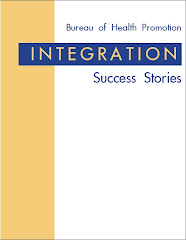Our annual fall retreat in October was dedicated to the topic of integration: what is it? Why is it important? Who will be involved? Where are we going?
“Integration” is certainly a buzz word in public health these days. But I truly think it’s more than just buzz—it is the future of chronic disease prevention and health promotion. The National Association of Chronic Disease Directors (NACDD) has dedicated an entire portion of their website to integration. Check it out: NACDD Integration Page—there are some great resources and examples from others! The goal of the National Center for Chronic Disease Prevention and Health Promotion at the Centers for Disease Control and Prevention is to integrate all funding streams within the center into a single cooperative agreement with each state. This process has already started with an integrated CDC cooperative agreement that pulls together funding for the Behavioral Risk Factor Surveillance System, Diabetes Prevention and Control, Healthy Communities, and Tobacco Prevention and Control.
At the retreat, I shared a definition of integration from NACCD:
"Integration is the strategic alignment of categorical program resources to increase the effectiveness and efficiency of each program in a partnership without compromising the integrity of categorical program objectives."
In this definition, the term “effectiveness” is critical, obviously. Our driving motivation is to be effective in improving health outcomes. Similarly, “efficiency” is equally critical. Integration shouldn’t be about creating more work for ourselves, but finding ways to work differently to make best use of our time and resources.
I’m so pleased to see the integrated work already happening in our Bureau—during the retreat an Integration Success Story report was shared, highlighting what I know are only a few excellent examples. Our BHP cross-coordination workgroups have been in place for several years, and have served to facilitate joint projects in a number of areas. But I know we can do more—my goal is a bureau culture in which all staff at every level, when launching a project, ask "How can we work together? How can a joint effort be more efficient and effective than working alone?"
During the retreat, we had a productive discussion about the benefits of integration including:
- Improved experiences for our customers, through better care, better access, and improved services;
- Improved ability of our programs to impact the whole person and whole family units;
- Working with a broader range of contacts—having a larger “work family;”
- One-stop shopping that’s easier for individuals, programs, and providers;
- Improved problem solving, involving more perspectives;
- Maximizing use of scares resources;
- Improved ability to capitalize on new opportunities;
- Improved sustainability of program efforts;
- Less confusion for the public and other stakeholders who don’t see nor understand the silos we sometimes work under.
This all said, we also noted at the retreat that sometimes integration ISN’T best. We can’t integrate just to integrate. The question that drives us must be “what is the most effective and efficient way to improve health outcomes?” We need to be strategic in answering this question. I look forward to working with you on this question in the next weeks, months, and even years.
I welcome your input! Where do you see BHP and integration in the next year? What do you think needs to happen? How do we make creating a culture of integration a reality?

I like the word integration, but I'm not so sure what it all means. I just want to figure out why I have to go to so many people just to figure out why my health is so bad.
ReplyDeleteNow, my doctor says that my diabetes is because I'm so overweight, but my belt size doesn't have a thing to do with my blood sugar. I'm glad to hear y'all are working on this stuff together, lets git r done!
@Laverl, have you seen the diabetes stories shared on the Faces of Diabetes (http://health.utah.gov/facesofdiabetes)? We have day-to-day people affected by diabetes sharing how they prevent and control diabetes! Let us know if it helps!
ReplyDeleteThis is just one example of the Bureau of Health Promotion integrating with other government agencies (public libraries) and non-profit associations (American Diabetes Association). And we could definitely become even more inclusive.
I'm excited to see more examples, ideas and questions shared on this blog!
A new way HDSPP is integrating is with WiseWoman. When Kalynn and I sat down, I realized they are already doing what we hoped for. We added a couple of activites and HDSPP is putting some items together for BEWISE. Simplier than I would have imagined.
ReplyDeleteNicole B.